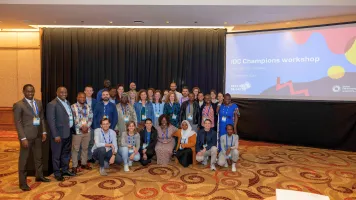This post originally appeared on Sightsavers on February 2022 and has been reposted here with permission. This piece is part of a Global Disability Summit blog series from Inclusive Data Charter Champions.
Across business, education, health, and other sectors, disability inclusion is gaining visibility, with organizations asking themselves how they can step up and drive real change. And in many cases commitments are being made to do more, to do better.
But are these commitments leading to real change? More than 15 years after the adoption of the Convention on the Rights of Persons with Disabilities, and more than seven years after the 2030 Agenda for Sustainable Development, which pledged to leave no one behind, why are people with disabilities continuing to face exclusion, discrimination, and barriers to accessing their rights in many parts of the world?
The upcoming Global Disability Summit (GDS) presents an opportunity to step up our efforts and make progress on disability inclusion. Making sure people with disabilities are counted and visible in data can help us to get closer to that goal.
Here are three ways governments and organizations can ensure that their GDS commitments result in real and lasting change.
1. Back up commitments with clear actions
More than 900 commitments were made at the first-ever Global Disability Summit in 2018. Around 100 of these were related to disaggregating data, which was a cross-cutting issue for the summit, recognising that better data is critical to addressing the barriers faced by people with disabilities. Fast-forward to now, and just under 25 percent of these data commitments have been reported as completed. Granted, many of the GDS 2021 data commitments are still underway and some have been delayed for a number of reasons – including the challenges presented by pandemic recovery, the impacts of which continue to be felt across the development sector and beyond.
But as governments and organizations prepare to renew and make new GDS commitments, it’s crucial to think about what it will take to implement them. Are they backed by clear, timebound actions? Is it clear who will be taking them forward? What resources will be put in place to implement them? These are some of the critical questions we need to ask – and answer.
2. Ask the hard questions and be accountable
With the increased focus on gathering more data on groups that are marginalized, transparency, accountability, and trust linked to the use of this data has become part of global conversations.
How do we ensure that the data collected is done in an ethical way that does not put people at risk of further discrimination? Are we being open and clear on why the data is being collected in the first place and how it will be used? What feedback mechanisms do we have in place to ensure that we are accountable to ourselves and our stakeholders on the way data is being handled? The purpose of disability-inclusive data is to drive change, but accountability measures must be in place to ensure that is done responsibly.
As we implement commitments on disability-inclusive data we must address these issues, working with people with disabilities and their representative organizations from data collection through to data use, to foster more trust in data.
3. Collaborate to address disability-inclusive data gaps
The Inclusive Data Charter (IDC) works with governments and organizations, supporting them to become ‘champions’, through making commitments and developing inclusive data action plans. More IDC champions are looking at how disability data intersects with other inclusive data characteristics like gender, age, location, and migratory status sharing knowledge and learning on good practice with others.
As part of our commitment to inclusive data, Sightsavers is strengthening the use of the Washington Group questions on disability in our programmes, sharing our challenges and learnings with others in the development sector. For GDS 2022, we are committing to publish an updated IDC action plan later this year. We will invest resources to increase the knowledge and skills of our staff and partners on disability-inclusive data, making sure that data is used to improve programme implementation. And we will advocate to encourage governments and organizations to prioritize disability-inclusive data, building on our successes in Pakistan, Senegal, and other countries, where governments, civil society, organizations of people with disabilities, and their representative bodies have worked together to take action.
Collaborating with networks like the IDC and the International Disability Alliance can help those who want to put their commitments on inclusion into practice and tackle the challenges and barriers to better quality disability-inclusive data.
It’s time to commit to change
Data and inclusion are closely connected issues. To be more inclusive, we need to understand the barriers and issues faced by people who are being excluded. And data is what gets us there, enabling us to look at the actions needed to close the gaps so that we can ensure more equitable outcomes for all. As the global community gathers for the second GDS summit, we need to commit to change and challenge ourselves to be more ambitious in accelerating our efforts on disability inclusion, underpinned by the use of disability-inclusive data. We must now move the narrative from why disability inclusion matters to how we will take action.
My hope for GDS 2022 is that we see more commitments backed by clear actions and, most importantly, we hold each other to account to make sure they are implemented afterwards. Because making a commitment is only the first step – it’s what happens after that really counts.


